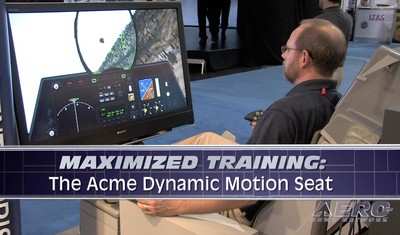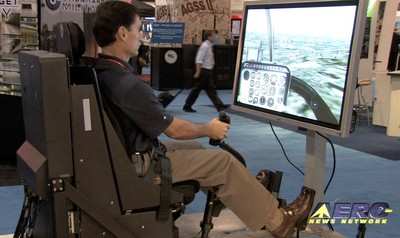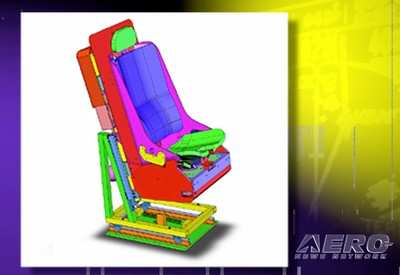Tue, Mar 10, 2009
You know the feeling... that 'seat of the pants' sensation that
cues into the true nature of the flight that you're undertaking...
its an innate part of the true world of flight... and possibly the
most difficult aspect of aviation to simulate.

But... imagine if some company put as much effort into the
recreating the 'seat of the pants' sensations as the sights and
more overt motions associated with flying? Well, imagine no more.
There seems to be a pretty impressive offering available and ANN
got a look at it for the first me at the 2008 I/ITSEC convention
late last year. The ACME Dynamic Motion Seat enhances simulation
training for any type of land, sea, or air vehicle by providing
high-fidelity realistic motion cues to the crewmember -- through an
extremely well-engineered seat.
It's a truly inspired device -- with a phenomenal bag of
tricks...

ACME claims that their DMS is a cost effective method of
providing motion cues to a pilot or other vehicle operator. The
seat accurately simulates the inertial cues experienced in the
operational equipment whether it be an aircraft or other platform.
ACME notes that, "Motion cues are important because they add the
realism necessary for the operator to respond more realistically.
The pilot first receives cues through the tactile and
proprioceptive sensors which precede the information received from
the visual scene. In very stable platforms, the need for motion
maybe minimal. However, in dynamic platforms, prompt attention is
necessary for the operator to maintain control and motion becomes
more contributory to the training. Researchers have drawn a
distinction between disturbance cues (system failures or external
environmental effects) and maneuver cues (controlling the aircraft
or other platform). When there is discontinuity between the visual
scene and what the operator is feeling on his/her body, the overall
effects can be disturbing."
The Dynamic motion Seat offers force cueing with four
degrees-of-freedom using electric servos. These cues provide
realistic kinesthetic (sense of movement) and somatic (skin
pressure) conditions using control algorithms designed to duplicate
the training vehicle environment.

Cues are provided via four independent axis of control using
three axis of movement -- vertical, longitudinal, and lateral.
Independent motions are applied to both the seat bucket as well as
the seat pan. Additionally, the seat back has independent motions
in the surge and sway directions. The surge motion provides the
motion cues for longitudinal acceleration while the sway motion
applies pressure to the trainee's side for lateral acceleration
motion cues. Combined seat motion is used to replicate roll and
pitch acceleration motion cues. A tactile sound transducer placed
in the seat pan to provide high-frequency vibrations.
Even the seat's belts and harnesses are modified to operate with
a drive linkage that can loosen or tighten, as needed, to emulate
positive or negative G-cueing.

More News
Aero Linx: International Association of Professional Gyroplane Training (IAPGT) We are an Association of people who fly, build or regulate Gyroplanes, who have a dream of a single >[...]
NORDO (No Radio) Aircraft that cannot or do not communicate by radio when radio communication is required are referred to as “NORDO.”>[...]
Beyond Visual Line Of Sight (BVLOS) The operation of a UAS beyond the visual capability of the flight crew members (i.e., remote pilot in command [RPIC], the person manipulating th>[...]
Aero Linx: Malibu M-Class Owners and Pilots Association (MMOPA) The Piper M-Class Owners & Pilots Association (PMOPA) is a not-for-profit organization dedicated to the interest>[...]
“After eight months of negotiating, and a failed TA, unfortunately management has not recognized the pilots’ needs. We have expressed to management that we are willing >[...]
 ANN's Daily Aero-Linx (05.29.24)
ANN's Daily Aero-Linx (05.29.24) ANN's Daily Aero-Term (05.29.24): NORDO (No Radio)
ANN's Daily Aero-Term (05.29.24): NORDO (No Radio) ANN's Daily Aero-Term (05.30.24): Beyond Visual Line Of Sight (BVLOS)
ANN's Daily Aero-Term (05.30.24): Beyond Visual Line Of Sight (BVLOS) ANN's Daily Aero-Linx (05.30.24)
ANN's Daily Aero-Linx (05.30.24) Aero-News: Quote of the Day (05.30.24)
Aero-News: Quote of the Day (05.30.24)






